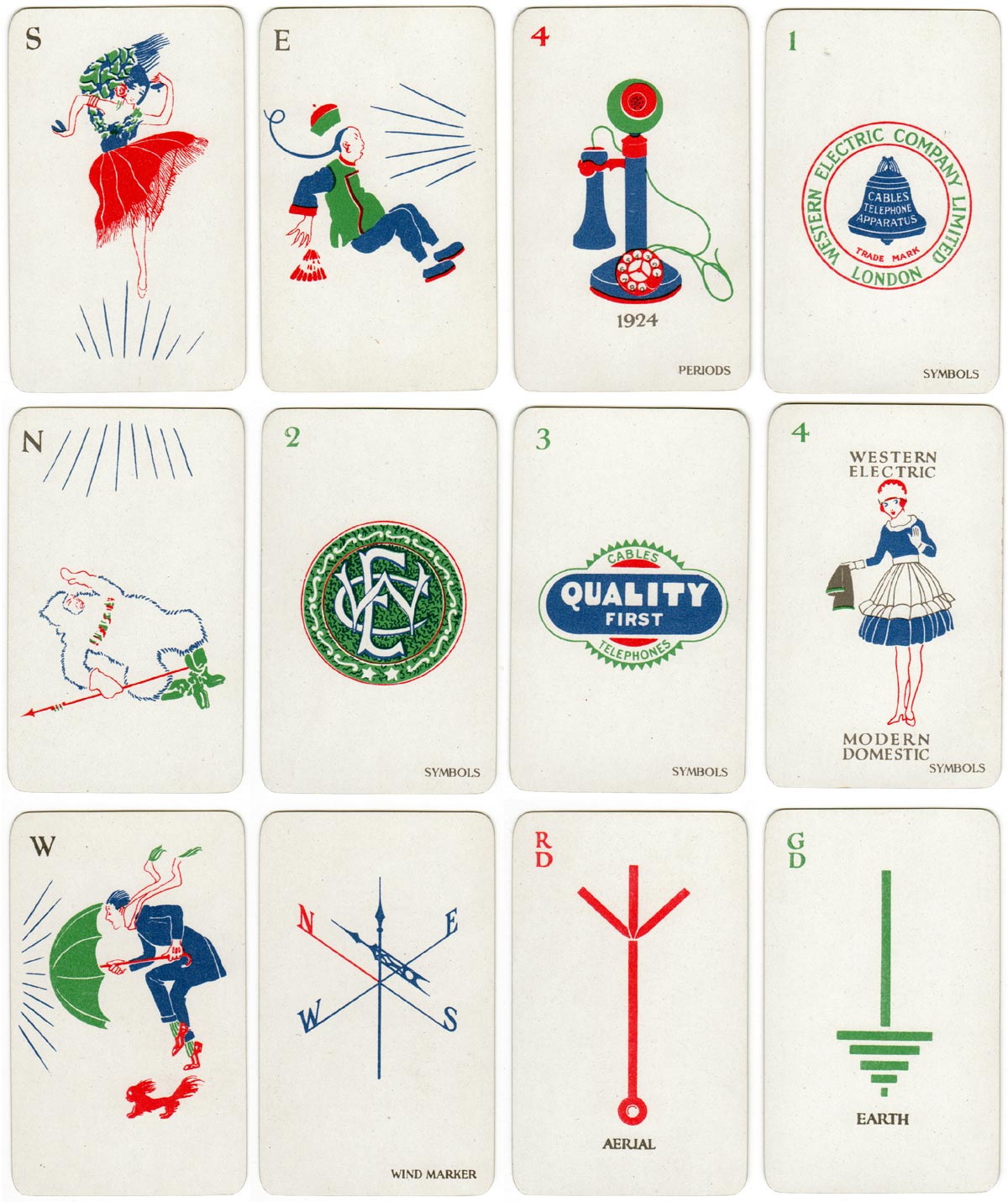Electrical Mah Jong
Electrical Mah Jong was produced by De La Rue for The Western Electric Company Ltd in 1924 for the Wembley Exhibition.
De la Rue & Co Ltd already produced conventional Mah-Jongg sets with bone and bamboo tiles, but this ‘Electrical Mah Jong’ card game was produced for The Western Electric Company Ltd in 1924 for the Wembley Exhibition, at which they had a stand, showing old radios, cables and telephones of the period from 1875 to 1924. At that time the Western Electric Company was a major player in the advancement of International Communications, producing over half the world’s telephones and a wide range of components, cables, wireless and receiving apparatus, some of which are illustrated on the cards below more →
See: the box • the score card.
Suits symbols are Phones (P), Radio Valves (R) and Cables (C). Winds are East, South, West, and North. Dragon Cards are Arial (Red), Earth (Green), and Ether (White). Red Honour Cards are Periods - 1875, 1898, 1918, and 1924. Green Honour Cards are Symbols - Western Electric Company Limited London, WEC, Quality First Cables and Telephones, and Western Electric Modern Domestic.


Above: cards from ‘Electrical Mah Jong’ produced by De La Rue for The Western Electric Company Ltd in 1924. 148 gold edged cards plus 4 scoring cards.

By Rex Pitts (1940-2021)
Member since January 30, 2009
Rex's main interest was in card games, because, he said, they were cheap and easy to get hold of in his early days of collecting. He is well known for his extensive knowledge of Pepys games and his book is on the bookshelves of many.
His other interest was non-standard playing cards. He also had collections of sheet music, music CDs, models of London buses, London Transport timetables and maps and other objects that intrigued him.
Rex had a chequered career at school. He was expelled twice, on one occasion for smoking! Despite this he trained as a radio engineer and worked for the BBC in the World Service.
Later he moved into sales and worked for a firm that made all kinds of packaging, a job he enjoyed until his retirement. He became an expert on boxes and would always investigate those that held his cards. He could always recognize a box made for Pepys, which were the same as those of Alf Cooke’s Universal Playing Card Company, who printed the card games. This interest changed into an ability to make and mend boxes, which he did with great dexterity. He loved this kind of handicraft work.
His dexterity of hand and eye soon led to his making card games of his own design. He spent hours and hours carefully cutting them out and colouring them by hand.
Related Articles

Agatha Christie and Playing Cards revisited
Agatha Christie uses card-play as a primary focus of a story, and as a way of creating plots and mot...

The Decadent Deck
Studies in the eroticism of the female body by Inge Clayton.

Historic Shakespeare
“Historic Shakespeare” playing cards featuring Shakespearean characters by Chas Goodall & Son.

Copechat Paramount Sorting System
Preserving the past: a specimen deck showcasing edge-notched cards and their ingenious sorting syste...

Heartsette by Herbert Fitch & Co, 1893
A glimpse into a busy print and design office in late Victorian London.

Intersigma
A Czech advertising deck for a company dealing with pump technology.

Rap Rummy
Rap Rummy made by Parker Brothers in 1926, only 4 years after the discovery of King Tutankhamen’s to...

Batman® playing cards
Batman playing cards published by InterCol of London 1989.

Can You Believe Your Eyes?
“Can You Believe Your Eyes?” playing cards featuring visual illusions & other oddities.

Pastime Playing Cards for the Blind
The “Pastime” Playing Cards for the Blind manufactured by Goodall & Son Limd., c.1910.

The European Interchanges Quartets
A card game based around motorway intersections from European countries.

Songs with Flute accompaniment
Eighteenth century English engraved cards with music for voice and flute.

Love Tests
Vintage novelty “Love Test” cards of a slightly saucy nature but all in good fun!

Briefmarken-Quartett
Quartet game featuring postage stamps from the Zones of Occupation in post-WWII Germany.

Ben 10 playing cards
Characters from the American animated television science fantasy series Ben 10.

Doctor Who Trump Card Game
Game for two players in which Doctor Who and the Legendary Legion join battle with the Alien Hordes....
Most Popular
Our top articles from the past 28 days











